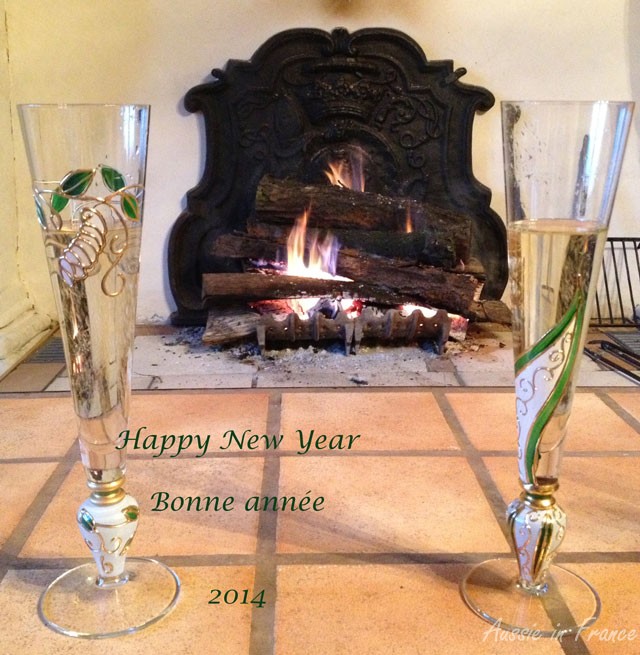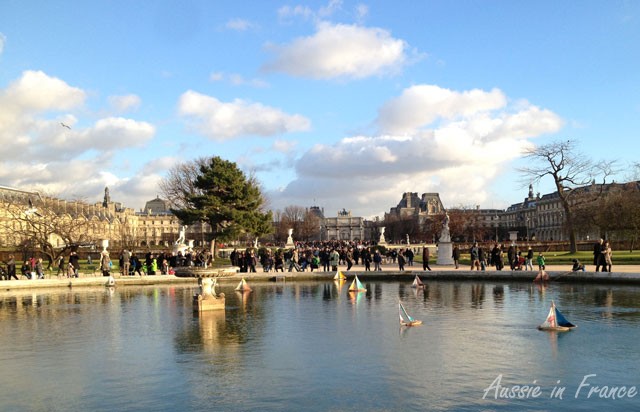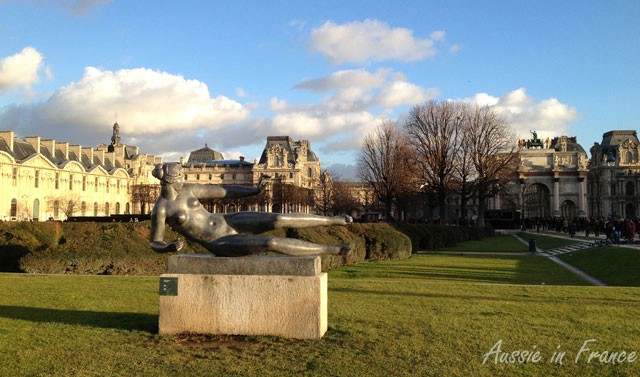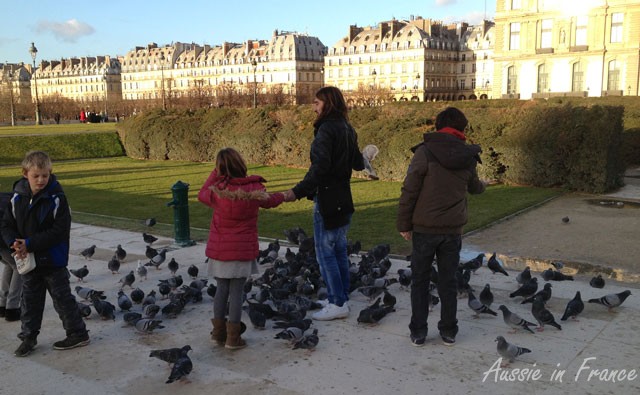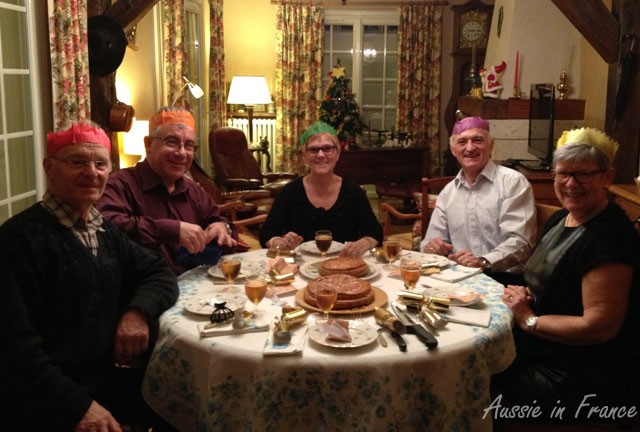 We were invited by our neighbours for a galette des rois. Liliane and Alain had bought two types – one with almond filling (frangipane) and one with apple filling just in case we didn’t like frangipane. I took along some Christmas crackers (or bonbons as we call them in Australia) which, surprisingly, I had found at Truffaut, the local gardening store, so we ended up with two sets of crowns! Françoise, being the youngest, should have gone under the table, but we let her close her eyes instead and indicate who should have which piece – not that Alain took any notice of her. He just went ahead and served according to the size of the piece! Jean Michel got the first fève and crowned Liliane who then got the second one.
We were invited by our neighbours for a galette des rois. Liliane and Alain had bought two types – one with almond filling (frangipane) and one with apple filling just in case we didn’t like frangipane. I took along some Christmas crackers (or bonbons as we call them in Australia) which, surprisingly, I had found at Truffaut, the local gardening store, so we ended up with two sets of crowns! Françoise, being the youngest, should have gone under the table, but we let her close her eyes instead and indicate who should have which piece – not that Alain took any notice of her. He just went ahead and served according to the size of the piece! Jean Michel got the first fève and crowned Liliane who then got the second one.
All posts by Rosemary Kneipp
Friday’s French – incinération
OK, this maybe isn’t the brightest subject in the world but it’s a very interesting false cognate. The first time I heard the word incinération used in French in relation to death I thought it was a joke. I couldn’t believe that incinération could really be the French word for cremation. But it is. And the verb is incinérer. It sounds so down to earth. They do say crématorium though and not incinérateur (except when talking about the cremator or high-temperature furnace). It seems, however, that with today’s environmental focus on waste incineration, crémation is becoming the more usual term.
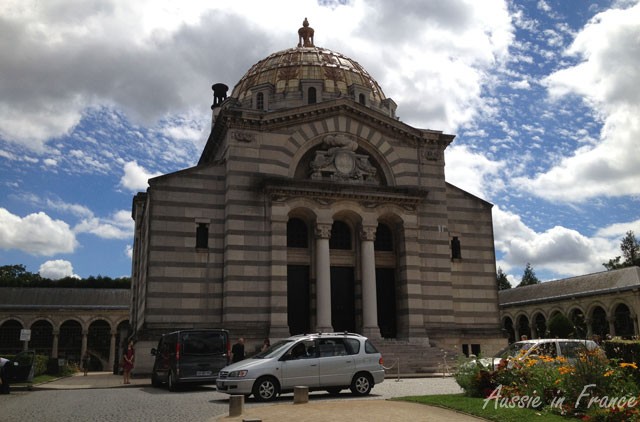
Not that I’ve been to a lot of crematoriums – or burials (inhumations) for that matter, I’m pleased to say, despite my age. In France – and this is borne out by IPSOS, the national survey institute – the trend is definitely towards cremation.
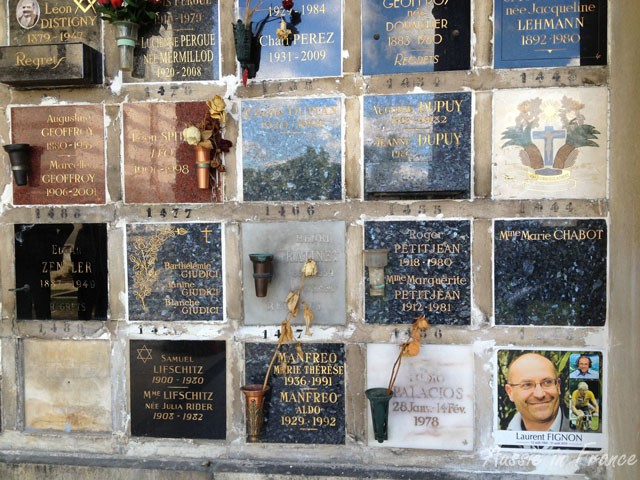
The nicest crematorium I’ve been to is Père Lachaise. An English friend’s mother was cremated there last summer. Given its celebrity, I would have imagined that it would be restricted to people living in the area, but apparently not.
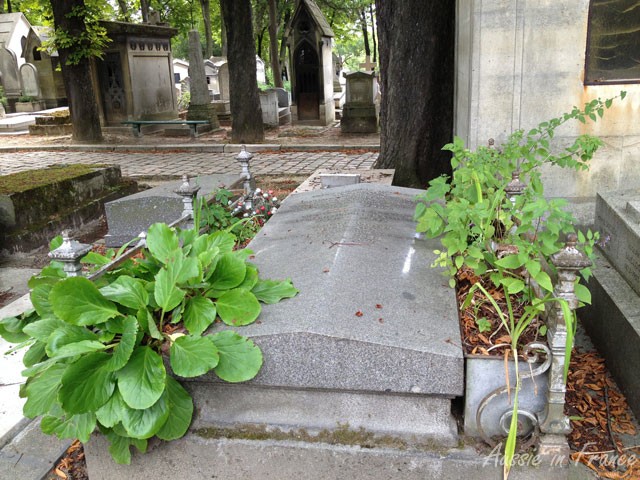
Before the ceremony, we wandered around the surrounding graves and it felt very calm and peaceful.
But I’m getting sidetracked. Another word used in relation to crématorium is columbarium from the word colombe which means dove. The columbarium is a wall with lots of little niches in which urns can be stored. The first time I heard the word was in the Cinque Terre where cremation is preferred to burial due to lack of space.
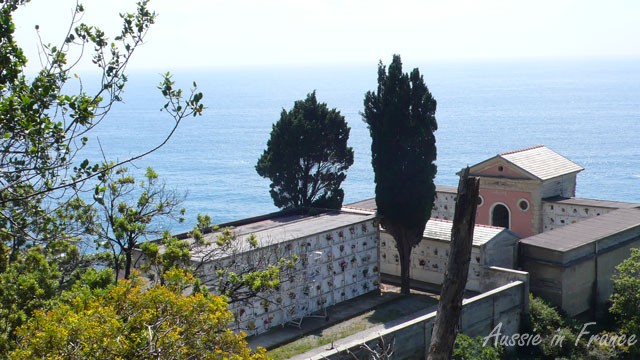
I don’t know about other countries but in France, you can’t just do anything with a person’s ashes (cendres). If you wish, you can disperse them in a site cinéraire in the crematorium, sometimes called a jardin de souvenir. If you’d like the ashes to be dispersed at the foot of a tree or shrub, it’s called mémorialisation.
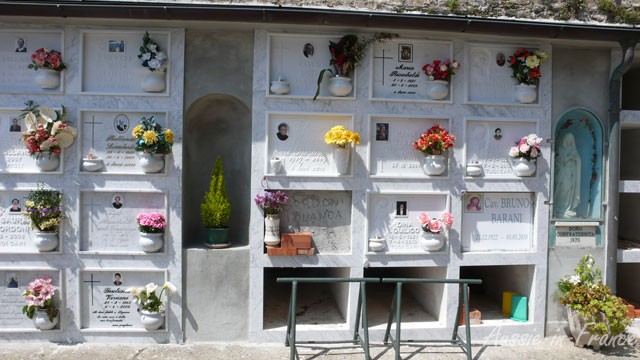
Outside the crematorium, ashes can’t be dispersed near a place of residence, so that rules out private gardens. Larger areas such as forests and meadows are possible, provided you have the owner’s authorisation. Dispersing them at sea is fine if you respect maritime law. You have to declare that the ashes have been dispersed at the town hall of the person’s birthplace.
You can bury the urn containing the ashes on private property if you obtain autorisation from the préfet first.
I found all that information in a little brochure at a crematorium in Greater Paris.
Weekly Blogger Round-Up: Galette des rois – The Cake of French Kings
For this week’s Blogger Round-Up and as a follow-up to my last Friday’s French post, I thought I’d find three different posts about the galette des rois or the French cake of kings, an increasingly popular tradition in France which starts on or about January 6th (feast of the Epiphany) and continues right up until the end of the month. Susan from Days on the Claise explains how to make your own galette, Mary Kay from Out and About in Paris reports on turning the tradition into a fund-raising initiative for maladies orphelines while Janine from The Good Life France gives us a very complete description of the galette and its various traditions. You might also like to read my own post on the subject written a couple of years ago. Enjoy!
Galette des rois, à peu près
by Susan from Days on the Claise, an Australian living in the south of the Loire Valley, writing about restoring an old house and the area and its history and running Loire Valley Time Travel.
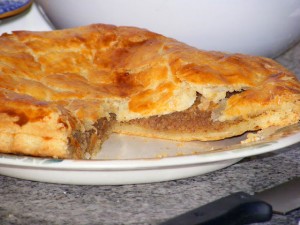 Now, I know that this is stepping dangerously into Walt’s territory, but since we are approaching Epiphany, I’m going to talk about making galette des rois.
Now, I know that this is stepping dangerously into Walt’s territory, but since we are approaching Epiphany, I’m going to talk about making galette des rois.
Well, sort of. I’m going to tell you how to make a quick and easy version, that, although it won’t be in the same league as Walt’s and your local pâtissière’s, is still a very acceptable addition to the post-Christmas table — and the real thing is getting very expensive, so homemade is an economical option! Read more
King Cake (Galette des Rois) and the meaning of “Maladie Orpheline”
by Mary Kay from Out and About in Paris, an American by birth, Swiss by marriage, resident of Paris with a Navigo Pass for the metro that she feels compelled to use
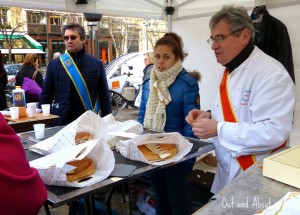 In spite of having been married to a native French speaker for many years, I’m not fluent in French. But since we raised our children in a bilingual home, my comprehension is usually fairly accurate. All of this is just a roundabout way of admitting that I felt really foolish after incorrectly translating maladie orpheline on Twitter. Here’s the tweet:
In spite of having been married to a native French speaker for many years, I’m not fluent in French. But since we raised our children in a bilingual home, my comprehension is usually fairly accurate. All of this is just a roundabout way of admitting that I felt really foolish after incorrectly translating maladie orpheline on Twitter. Here’s the tweet:
Best pastry chefs in Paris sell King Cakes to fight childhood illnesses. Jan 4. Place Saint-Germain des Prés:quefaire.paris.fr/fiche/76201_la…
In a hurry to help spread the word about a fund-raising initiative by some of the top pastry chefs in Paris, I didn’t take the time to google maladie orpheline. Instead, I rapidly translated it as “childhood illnesses” and waited until my walking French dictionary returned home from work. “I’m confused about something.” Read more
Galette des Rois – The French Cake of Kings
By Janine Marsh from The Good Life France, an independent on-line magazine about France and all things French, covering all aspects of daily life including healthcare, finance, utilities, education, property and a whole lot more.
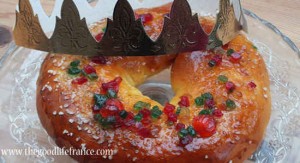 The 6th of January is a special day in France, it is the 12th day of Christmas, the date of the Epiphany and most importantly the day when all over France the cake known as galette des rois is traditionally served.
The 6th of January is a special day in France, it is the 12th day of Christmas, the date of the Epiphany and most importantly the day when all over France the cake known as galette des rois is traditionally served.
This flaky cake known as the King’s Tart is a piece of French gastronomic history which goes back several centuries.
The cake is made of a seriously buttery puff pastry, filled with almond paste, baked and often decorated beautifully with candied fruit. Patisseries and boulangeries compete to create the most magnificent of cakes and supermarket shelves will be heaving with boxed galette des Rois from the end of December. Read more
Château de Beauregard – 327 historical portraits
We kept on passing Château de Beauregard when cycling to Chambord and Cheverny, so we finally scheduled a visit on a Sunday morning in March. We were surprised to run into friends from Montrichard who had just finished their visit! It’s a small world, isn’t it?
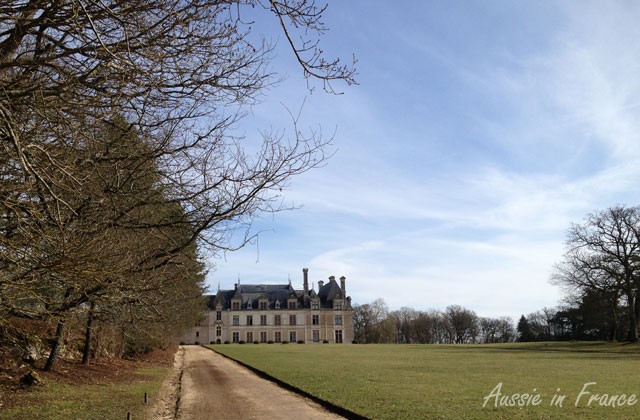
The château started off as a manor house in the 15th century and was confiscated from the owner, François Doulcet, by Louis XII when he was found guilty of embezzlement. François I used the house as a hunting lodge before giving it to his uncle René de Savoie who sold it to Jean du Thier, Henri II’s finance minister in 1545. Work carried out between 1553 and 1559 turned Beauregard into one of the finest châteaux in the Loire Valley. A gallery and an L-shaped wing were added to the original building.
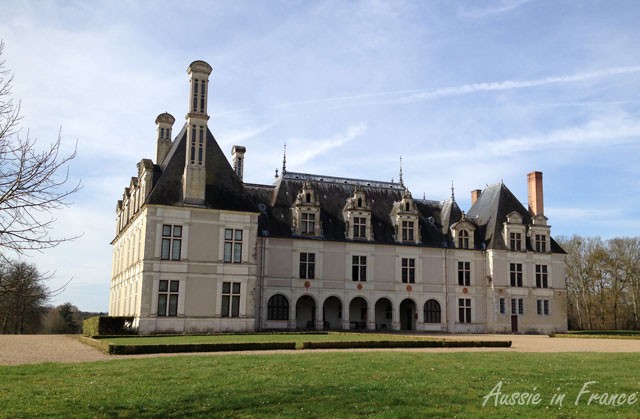
The harmonious Italianised architecture includes arcades in the gallery surmounted by terracotta medallions. Its high white chimneys “à la Chambord” are incrusted with slate. All that remains of Jean du Thier’s interior decoration, however, is the Cabinet des Grelots, his work cabinet, with its delicately sculpted caisson ceiling completed in 1554 by the royal cabinetmaker Scibec de Carpi. The name grelot is derived from Jean du Thier’s coat of arms: 3 gold bells (grelots) on a blue background.
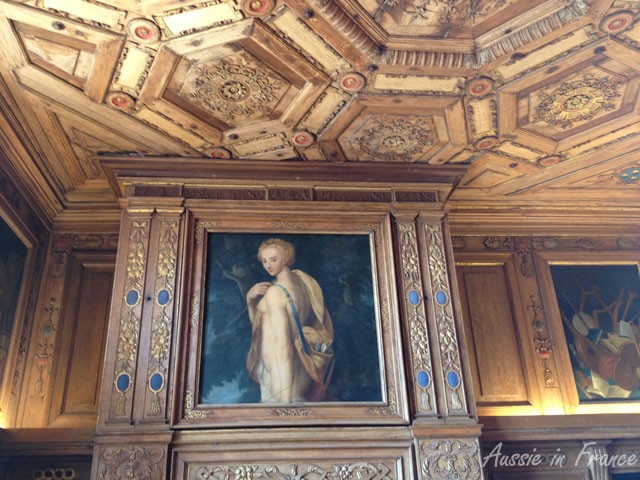
But it was Paul Ardier, Louis XIII’s minister who was responsible for its most prominent feature. After retiring from political life, he decorated the Grand Gallery between 1620 and 1638 with 327 portraits spanning three centuries (1328 to 1643), forming the largest collection of historical portraits in Europe. They are not all works of art, of course, but the collection is impressive.
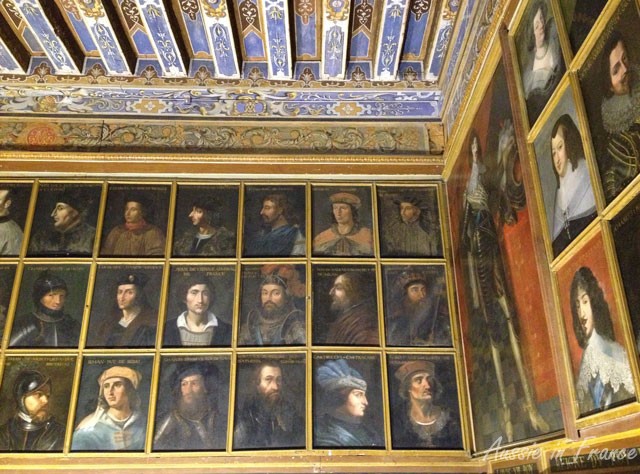
Ardier’s son and granddaughter added the Delft floor tiles, lapis lazuli ceiling and sculpted murals. The Ardier family left the château in 1816.
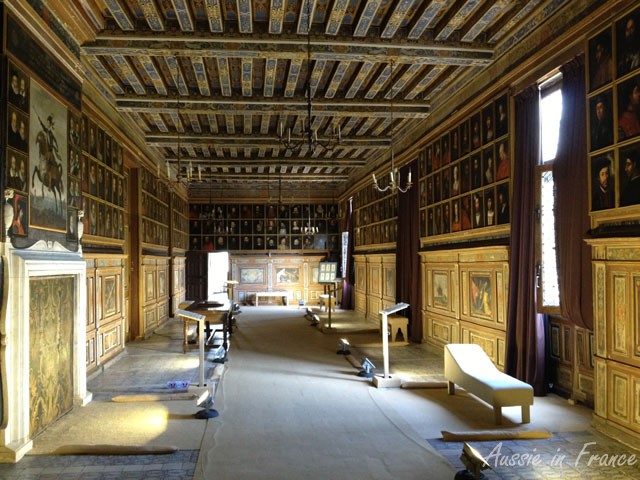
The west wing was destroyed in the 19th century and a second gallery built on the south side. It was modernised in the 20th century by the Tillier family before being bought by the Pavillon family in 1925. It was opened to the public in 1957. Restauration is ongoing and the landscaped park has now been completely restored.
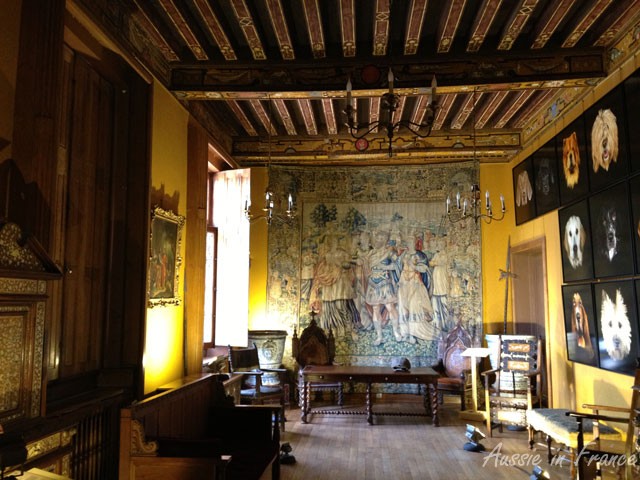
The château also houses a portrait exhibition of dogs owned by famous people. The International Animal Portrait festival was launched in 2012.
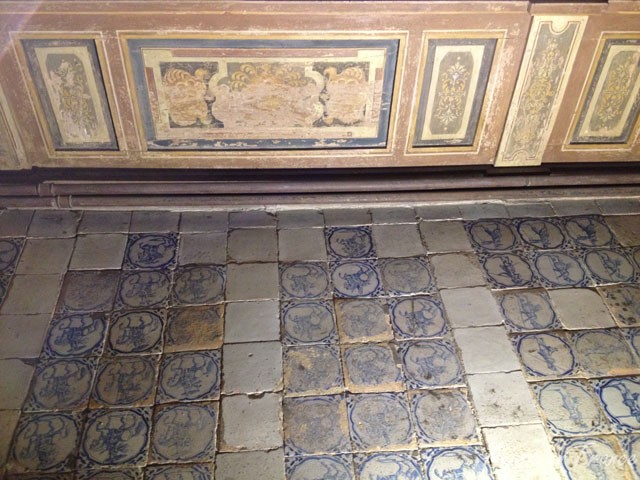
We did not explore the grounds which are obviously not their best in mid March. The Cabinet des Grelots and the Portrait Gallery in particular are quite exceptional but the other rooms are somewhat disappointing.
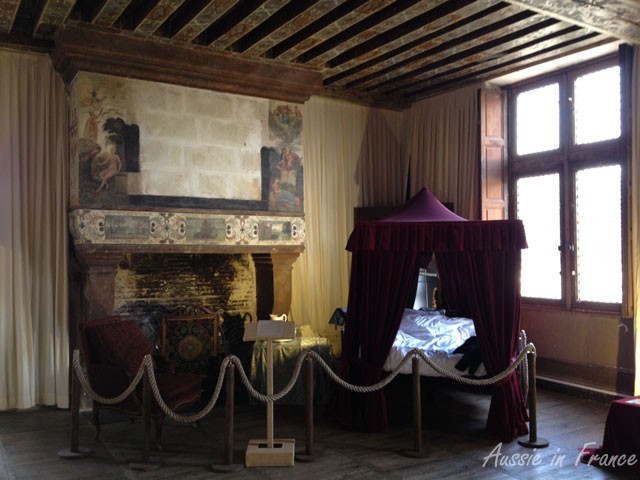
Some effort has been made to recreate the atmosphere in one of the bedrooms but I’m afraid it’s not very convincing. Dog lovers, however, will no doubt appreciate the exhibition, even if it seems a little incongruous.
Opening hours 18th November to 14th February, by reservation only (groups). 15th February to 30th March 11 am to 5 pm, 31st March to 29th June, 10 am to 6 pm, 30th June to 31st August, 10 am to 7 pm, 1st September to 2nd November, 10 am to 6 pm, 3rd November to 11th November, 11 am to 5 pm. Restaurant open from 10.30 am to 6 pm from 1st to 29th May, July and August. Prices Park and château : 12.50 euro (park only : 9 euro); children from 5 to 13 : 10 euro (park only : 9 euro)Photos of the Week – New Year and after
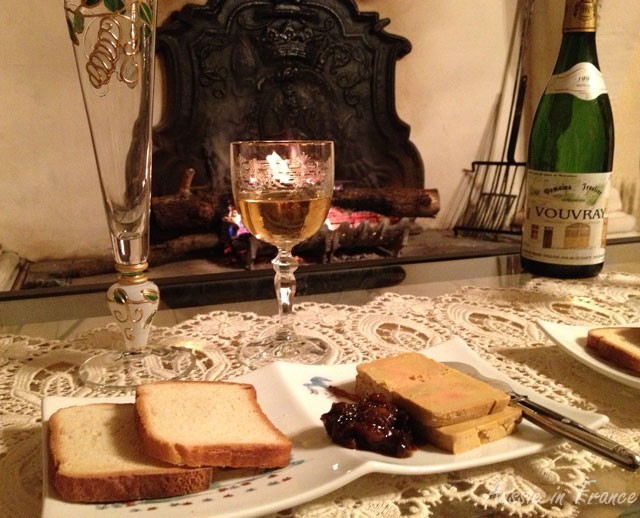

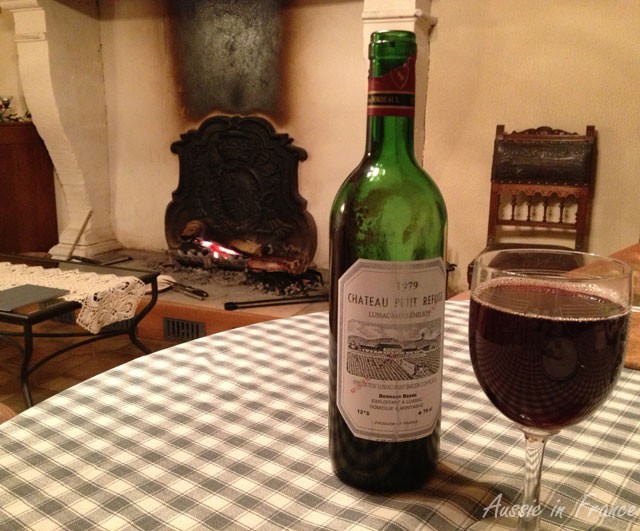
Friday’s French – bonne année
I couldn’t resist the temptation to take a look at new year’s greetings in France particularly since I overheard my father-in-law explaining the tradition of mistletoe in France to Jean Michel and it didn’t seem very clear to me so I checked it out.

There are several different explanations but it seems that the Druids used to say o ghel an heu, meaning “may the wheat germinate”, when they cut the sacred mistletoe at the winter solstice. This seems to have gradually muted into kissing under the mistletoe at new year and saying au gui l’an neuf which is a corruption of the original Celtic expression and doesn’t have any obvious meaning on its own. I’ve never actually heard anyone say it.
Later, the expression became Bon an mal an, Dieu soit céans, i.e. good year, bad year, may God be with you. By itself bon an mal an means on average as in our expression taking one year with the other. Bon an mal an, l’immigration se maintient au Québec = Immigration in Quebec is about the same each year.
Nowadays the most common new year expression is bonne année ou bonne et heureuse année often followed by et la santé surtout as you get older and health becomes more of an issue. You wish people bonne année the first time you see them throughout the month of January. You can also say meilleurs vœux (best wishes), je vous souhaite une excellente année 2014 (I wish you an excellent 2014), que vos vœux les plus chers se réalisent (may your dearest wishes come true). Santé, joie and bonheur (health, joy and happiness) are usually in there somewhere as well. Jean Michel’s favourite is Bonne année et bonne santé physique et morale. He says that way he’s covered everything.
Note that you don’t say nouvel an except when you’re referring to new year’s eve or new year’s day e.g. je vous verrai au nouvel an : I’ll see you at New Year or nous avons fêté la nouvelle année en famille : we celebrated new year at home. A new year card is une carte de nouvel an or une carte du nouvel an but it’s probably more correct to say une carte de vœux de/du nouvel an. You don’t see them much any more but when I moved to France in 1975, people used to send tiny cards about half the size of a normal envelope.
Something I find interesting is that Jean Michel never bothers to contact his family at Christmas but makes sure that he talks to everyone on New Year’s day. For me and my Australian family, it’s quite the opposite. Christmas is more important.
And there is an unwritten rule that the younger members call the older members first. As Jean Michel’s the oldest, he only has to call his father.When I sent messages to both my children at midnight on New Year’s Eve this year, he was quite surprised that I didn’t wait until they contacted me.
Today the galette des rois or kings’ cake is probably the greatest symbol of the new year in France. A galette was originally a buckwheat pancake from the country of the Gauls (Gallois) and by extension any thick, flat cake or biscuit. I’ve described the tradition of the galette des rois in another post. Today I’m only looking at the linguistic aspect.
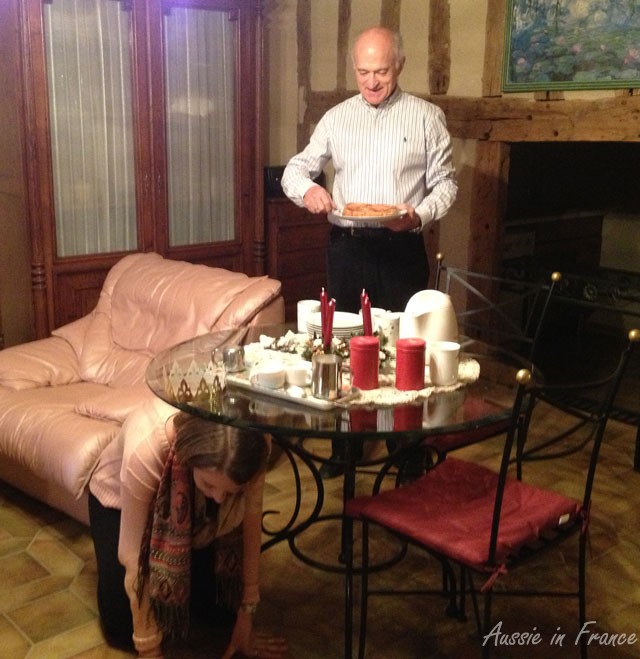
A popular expression connected with the galette des rois is tirer les rois. Tirer means to draw stakes, so tirer les rois means that people are going to share a galette and see who gets the token or fève inside.
But each region of France is different so you may know of other new year traditions.
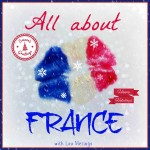 This post is a contribution to Lou Messugo’s All About France link-up. Feel free to pop over and have a look at the other posts this month by clicking here.
This post is a contribution to Lou Messugo’s All About France link-up. Feel free to pop over and have a look at the other posts this month by clicking here.
Blogging in 2014
Yesterday’s five New Year resolutions didn’t mention Aussie in France despite the fact that it is now an integral part of my life.
After more than two years of blogging I’m still enjoying it as much as ever and never have writers’ block . However, there is no denying that it’s time-consuming even though I’ve become more proficient with regards to the technical side of things.
From my original seven posts a week, I cut down to five then to four. I gradually introduced regular features : Sunday’s then Monday’s Photo of the Week/Travel Photos, Wednesday’s Blogger Round-Up, now the Weekly Blogger Round-Up and Friday’s French.
I’ve been invited to guest post on several sites : My French Life, Home Exchange, Holidays to Europe, Frugal First Class Travel, Expat Blogs, The Good Life France and Contented Traveller (though the last two are still in the making).
I’ve made new friends among other bloggers and have had the great pleasure of meeting some of my readers. I’ve now published nearly 600 posts which has attracted over 8600 comments.
Blogging not only satisfies my creative urge, it also makes me appreciate my surroundings more and get more out of everything I do because I know I’ll be able to share my photos and stories.
Sometimes I get discouraged and wonder whether it’s worth it. Inevitably I receive a comment or an email from someone I don’t know telling me how much they enjoy my posts and my batteries are recharged.
I would like to ask you, my readers, which posts you enjoy most: travel photos, photos of Paris or the Loire, the blogger round-up, Friday’s French, posts on visits to châteaux and exhibitions, stories about life in France, our renovations, cooking, dieting, cycling, more personal posts, more factual posts …
Would you like to see posts on other subjects in particular?
Also, how many posts do you have the time or inclination to read each week?
Another question that interests me is how you came upon Aussie in France and what made you keep reading it.
After a discussion with Leonardo, I have a new feature in the making that I hope will be ready very soon.
Thank you for your answers and stay tuned!
Happy New Year 2014 & Five Resolutions
This year we ARE sitting in front of a roaring fire in the renovated upstairs fireplace, unlike last year when we decided not to herald in the New Year until the renovation was finished. We finally lit our first fire on February 28 only to the discover it smoked. The problem was eventually solved in March when the roofer opened up the top of the chimney. By then it seemed a little late to welcome in the New Year.
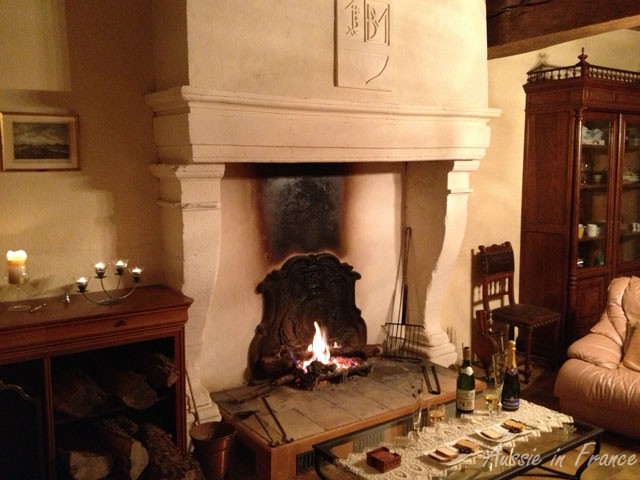
Having just reread my resolutions, plans and expectations for 2012, I see that I have failed miserably with the first, which was NO MORE RENOVATION until we move here permantly. Yes, well, I haven’t mentioned it because it isn’t finished (ha! ha!) but Jean Michel is making an upstairs kitchen because once we got the fire going in October, we decided it would be cool – or should I say warm – to have breakfast and apéritifs dinatoires in the upstairs living room.
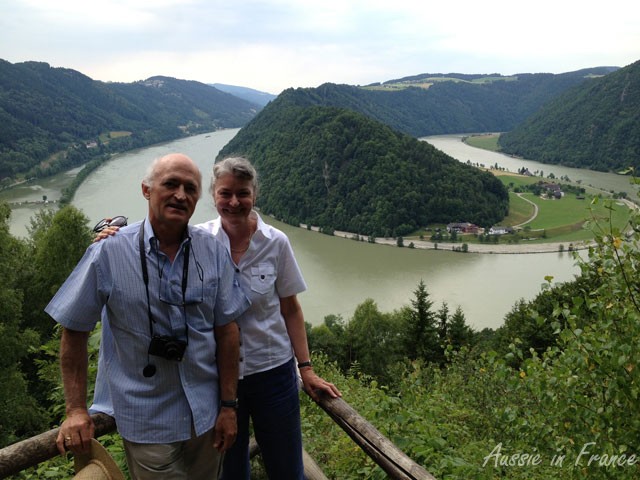
I’ve done better with the second resolution to travel more in Europe. We loved Barcelona and our cycling trip along the Danube in the summer which included Germany, Austria, Slovakia, Hungary and Switzerland, was undoubtedly my best holiday ever. We also unexpectedly went to Sofia and Plovdiv (which reminds me I still have a post to write …).
My third resolution was to go back to fitter occupations and lose the 3 or 4 kilos I’d gained. No problem about that one – our 1,100 kilometers of cycling along the Danube plus all the other shorter cycling holidays have certainly made me fitter. Discovering the 5:2 fast diet is now a way of life. I lost the extra kilos and am now able to enjoy foods I thought I had banished forever.
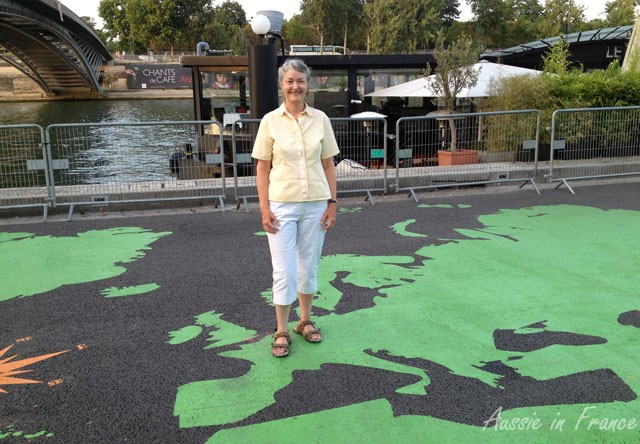
I’m not sure about my fourth resolution of getting out and about in Paris more. I certainly did during the summer months particularly on the banks of the Seine, but as the days get shorter, so does my resolve. I do have the excuse of being in Blois a lot during the winter!
The last resolution was to make the most of my iPhone camera particularly at night. I did learn to do fashion shoots when Black Cat was setting up her sewing blog and I created a second photo blog, Blois Daily Photo, in July but I haven’t made any progress with night photography so I can put that back on the list!
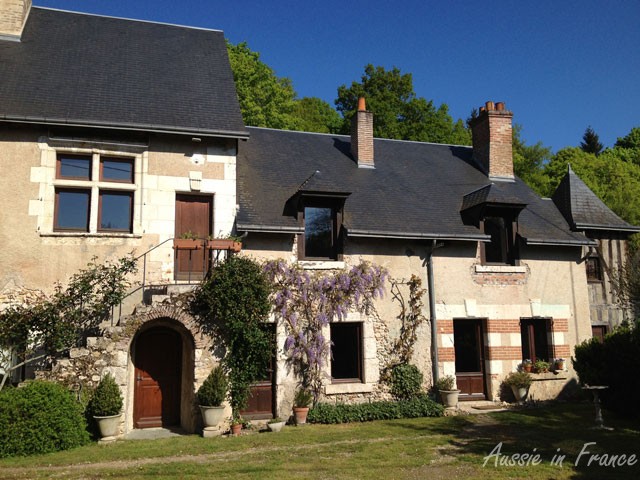
My first resolution for 2014 is to have a maximum number of holiday bookings for Closerie Falaiseau between 1st April and 30th September. We rented for a total of 19 weeks in 2013 so are not far off our goal. All our guests were lovely and gave us wonderful reviews. One extremely nice American couple came back again and have already booked for 2014.
The second resolution is a bit tougher. I’d like to diversify into some sort of tourist-related activity in Blois but it still needs a lot of defining and requires more energy than I seem to have at the moment. Maybe along the lines of the THATlou treasure hunt, walking tours, visits to châteaux, mushroom picking, organisation of short stays in the Loire Valley …
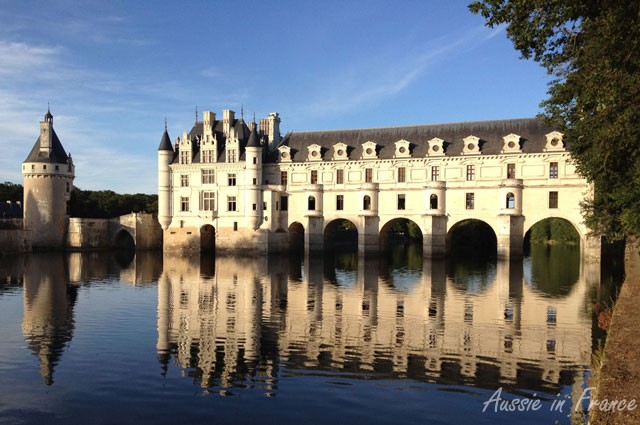
Another long cycling holiday is my third resolution so we’ve started looking at the map. Perhaps in the northern part of Germany along the Rhine. In the meantime, we have organised a home exchange in Venice at the end of April!
My fourth resolution is to discover the secret of getting enough sleep. Maybe if I set it as a goal, I might actually be able to do something about it! Who knows?
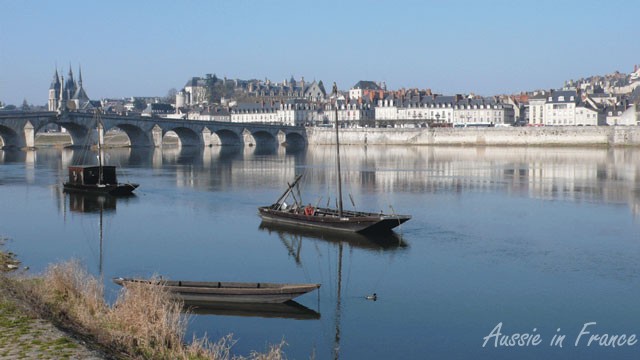
And the 5th is improving my night photography skills.
How about you? What are your new year’s resolutions for 2014?
As one of my friends so cleverly put it: may 2014 bring what 2013 forgot!
Photos of the Week – Tuileries Gardens in December on a sunny day
Friday’s French – chevreuil, biche & deer
I’m telling someone about our little wood and explain that the biches ate all our medlars. “We don’t have any biches“, says Jean Michel. “We only have chevreuils“. “Isn’t it the same thing”, I ask. “No, it’s not. The only thing in common is that they’re all cervidés“, he replies. “Well, they are all deer to me”, I answer.
And there you go. It’s one of those words where the generic is used in English with something tagged on to describe the individual species. Remember nuts? I then asked what the difference was between a biche and a chevreuil. “The biche is much bigger”, I’m told. So we turned on the iPad and this is what we found.
First, the word biche is sometimes used incorrectly. It should only be used to designate the female of a cerf. But I thought a cerf was a stag which is a male deer so there is obviously something wrong. You can hardly talk about a female stag, can you? I then find a wonderful document on www.gmb.asso.fr by the Groupe Mammalogique Bréton.
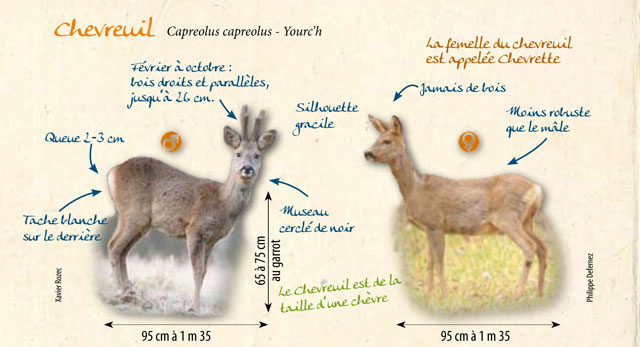
Chevreuil is capreolus capreolus and when I look for that in English I find European roe deer, also known as western roe deer, chevreuil or just roe deer. We now have the size: 65 to 75 cm high, and learn they have a white patch on their rear (bean shaped for males and heart-shaped for females). The tail is 2 to 3 cm long and the males have antlers of up to 26 cm, called bois which literally means “wood”, but we’ll come back to that later. The female is called a chevrette.
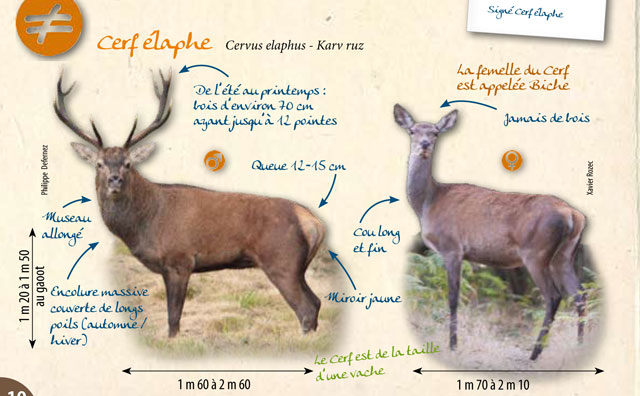
Here we have our cerf élaphe or cervus elaphus, red deer in English, one of the largest deer species. It is much taller, 1 m 20 to 1 m 50, has a 12 to 15 cm tail, yellow rear, massive neck and 70 cm antlers with up to 12 points. It specifically says, “The red deer is the size of a cow”. No, I have to agree, we don’t have any biches in our wood!
Since the stag and doe question is bothering me, I do some more research. In English, I find various sorts of deer such as fallow deer, reindeer and elk. I learn that the word “deer” was originally broader in meaning and meant a wild animal of any kind as opposed to cattle.
Usually, the male is a “buck” and the female a “doe” but there are regional variations. “Stag” is used for many larger deer and sometimes even “bull” and “cow” are used. The male red deer is a “hart” and the female a “hind”. Young deer can be called fawn for the smaller species and calf the the bigger ones. A castrated male deer is a havier, which I have never heard of before.
Now let’s have a look in French. A fallow deer is a daim and the female is daine. The female of renne (reindeer) is renne femelle which isn’t very exciting, is it? Elk is élan and follows the same rule. The names for the young are much more complicated: faon is used for the cerf, chevreuil, daim and renne; hère for a young cerf aged 6 months to one year with no antlers; daguet applies to a young cerf with his first set of antlers and brocard is a male chevreuil more than one year old. I’m sure I’ll remember all that!
To sum up, they are all called deer in English and all called cervidés in French but you need to make the distinction in French between the different species. The term “cervids” exists in English but is a scientific term and most lay people probably wouldn’t know what it was.
And to quote Susan from Days on the Claise in her comment: “Really big deer (American elk, moose) are bull and cow; big deer (red) are stag (cerf) and hind (biche); small deer (fallow, roe) are buck and doe. The only red and fallow deer you will see here are captive (farms or deer parks) although they would once have roamed freely as wild animals. Roe deer are common in the wild (too common, in fact, and need culling). Hart is an old fashioned word for stag that you won’t really find used these days.”
Since antlers are called bois, I checked what they are made of. They are an extension of the animal’s skull and are actually bones. Velvet covers a growing antler and provides it with blood, supplying oxygen and nutrients. Fascinating. Surprisingly, antler comes from Old French antoillier (from ant-, meaning before, oeil, meaning eye and -ier, a suffix indicating an action or state of being, so kind of loosely “behind the eye”. But in fact there is another word relating to antlers in French – andouillers are the branches of the antlers, called tine in English which, as we all know (knew?) are also the prongs of a fork or comb.
Next time I mention the medlars I shall definitely talk about chevreuils.

